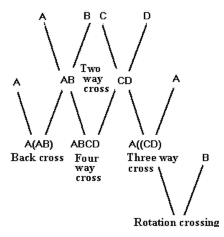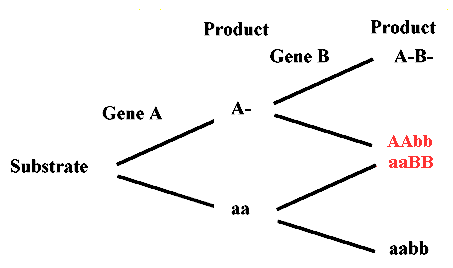
The effect of crossbreeding is the opposite of the effect of inbreeding. Crosses are more heterozygotic than individuals in a pure bred population. Contrary to inbreeding, where a linear negative relationship with fitness and production traits and the degree of inbreeding, it is impossible to predict anything about the effect of crossbreeding.
How is it possible to establish a sensible system of crossbreeding? The only possible method is 'the trial and error method'. Today a large part of the practical production of poultry, mink and pigs is based on production crosses, so the 'the trial and error method' is not as bad as it might sound. If a combination, showing a good crossbreeding effect or heterosis, is found, this combination can be repeated infinitely. Apparently, a certain heterosis does not depend on the level of pure breeding. Pure breeding or out breeding has not been defined earlier, but the words indicate that neither inbreeding nor crossbreeding occur, therefore breeding in a larger population of domestic animals is referred to as pure breeding or out breeding. This definition corresponds closely to the definition of a H-W population with less strict random mating requirements. Hybrid vigour is, as it says, a special vigour, which occurs as a consequence of crossbreeding. Another word used for a cross is a hybrid, which has then coined the term. Vigour is materialized in more robust animals with larger production capacity than pure breeds. Heterosis means the same as hybrid vigour. The word indicates that the effects are caused by increased heterozygosity.
Figure 9.2. Systems for crossbreeding.
 |
Systems for crossbreeding. Figure 9.2 shows four breeds or lines, A, B, C and D. Crossbreeding can be carried out as two way, three way or four way crosses, backcrosses, or rotation crosses.
Two way crosses - a cross between two lines A and B.
Back crosses - the crossed animal, AB, mated with either line A or B.
Three way crosses - the crossed animal, CD, is mated with a third line A.
Four way crosses - the crossed animal, AB, is mated with the crosses CD.
Rotation crossbreeding can be carried out with 3, 4 or 5 breeds or lines. In
this case 4 is used, the next breed to be used is C and then D. Normally
the females are crosses while the males are pure bred animals.
The two-way crossbreeding only gives heterosis in the offspring. To retain heterosis
in the maternal traits, three way or four-way crossing has to be applied.
Systems for crossbreeding automatically ensures as low an inbreeding as possible in the production
animals. Thus the advantage of crossing systems is that no special
action has to be taken in order to maintain minimal inbreeding.
The traits, which give largest hybrid vigour, are traits with low heritability, which implies that hybrid vigour is mostly
found in reproduction traits.
Figure 9.3 shows an example of hybrid vigour in mice on the number of young a female can produce in a lifetime. The most popular system for crossbreeding has been applied: two- and three- way crosses, and back crosses. (Data from Newman et al. J.Anim. Sci. 61 358-365, 1985).
Figure 9.3. Effect of crossbreeding in mice.
 |
As seen in Figure 9.3, the hybrid vigour is very high in this example as mice of pure lines only get half the number of young that the cross bred mice get.
The effects can be divided into either an effect on the foetus or an effect on the mothering abilities. The difference between the two lower curves shows the effect on the foetus, if it is a cross or not. The lower curve represents pure bred foetuses in pure bred mothers. The second lower curve represents a cross foetus in a pure breed mother. The difference between the two lower curves and the two upper ones shows the effect of a female being a cross or not. It is clear that most of the hybrid vigour is in the maternal part, and it concerns the ability to ovulate a large number of oocytes and hold them throughout the pregnancy.
The example in Figure 9.3 shows a large amount of hybrid vigour. This
is very rare, but in animal breeding it is common to see effects of
up to 10 %.
Calculation of the hybrid vigour is done as follows: (average of the crosses minus average of the pure lines) in relation to the average of the pure lines.
Example of swine: Landrace Yorkshire crosses give an extra piglet per litter compared to the pure bred sows, which
get an average litter size of 10.
Hybrid vigour (11-10)/10 = 0.10 or 10% for litter size in swine in the mentioned combination.
To carry out a cross production program it is necessary to maintain well defined lines, and that the animals are bred in sufficiently large numbers both to maintain them self and to produce a sufficient amount of animals to get into the crossbreeding program. The necessary surplus of animals for breeding is not always present. This however is not the case in the Danish dairy breeds. Largely all females are used for breeding, as the birth rate for the Red Danish and for the Holstein Frisian is only slightly above two. A ratio of 1.1 to 1.2 heifer calves have to born in order to replace their mothers, so the birth rate is just high enough to maintain the population. Rotation crossing though can be practised outside the pure breeding kernel. The hybrid vigour is significantly lower in rotation- than in three way crossbreeding.
An extra advantage using crossing is the uniformity, which is attained when at leas one of the parents is a pure bred animal. In a German investigation was found that the phenotypic variance in back fat thickness in swine was 30 per cent lower in L x Y crosses than in the corresponding pure bred animals (Lutaaya et al. 2001, 79:3002-07).
Figure 9.4. Two gene pairs and possible
biochemical pathways. New
combinations are not allways
beneficial.

|
Negative recombination effect in F2: In the shown crossing systems, at least one of the parent breeds was a pure bred. If an F2 is produced, this is not the case. Production based on F2-animals or crossbreeding between different crosses is normally a bad idea compared to backcrosses or three way crossing. The latter has the largest heterosis effect. In F2s so-called negative recombination effects can occur. This is caused by combinations of genes, which did not exist in any of the original breeds. For instance if a F1 is made by crossing aabb x AABB in F2 animals of the type aaBB AAbb will occur, which were not found in any of the original breeds. These types can be lethal, see Figure 9.4 for the biochemical pathways. The F2 will furthermore be more heterogenous than all other crosstypes or pure breed animals.
By incrossing it is possible to improve a breed by using a few superior animals from outside the breed. Normally animals from closely related breeds are
used because they have the desired characters to save the best of the original
breed. For this to succeed the selection must be light in the first generations of the incrossing. After incrossing
some of the recombinant types are of higher interest and it can take several generations
for them to occur
Figure 9.5. A pair of homologous
chromosomes from an original and an
incrossed individual before recombination.
 |
Figure 9.5 shows homologous chromosomes with four gene pairs which affect a quantitative character. Genes can be mixed so that it takes several generations for the desired combination, one chromosome having all the plus signs, to occur. See also section 2.5 for linkage disequilibrium.